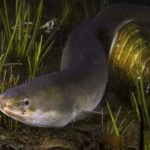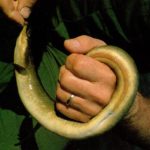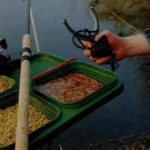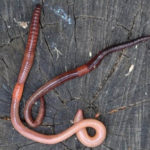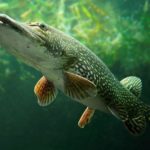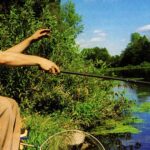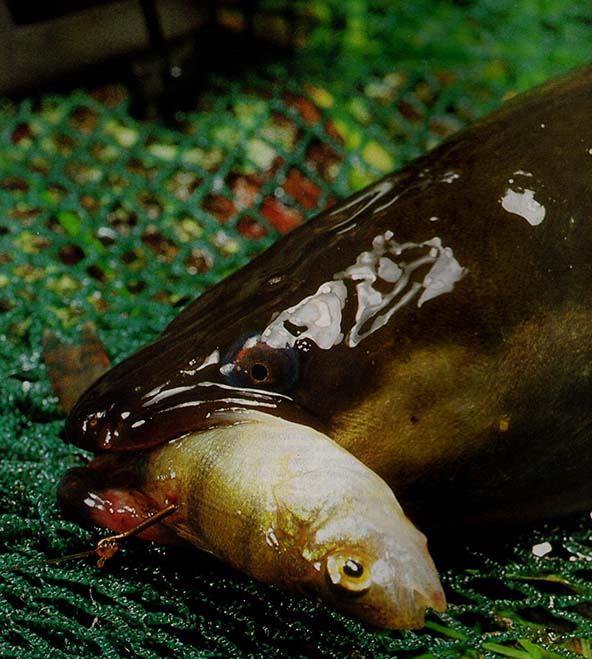 Idea łowienia węgorzy nie na całe robaki, lecz tylko na kawałki rosówek lub czerwonych robaków, zaświtała mi w głowie z tego względu, że zawsze miałem dobre wyniki w łowieniu na kawałki martwych rybek. Na początek eksperymentowałem trochę z moim węgorzem w akwarium. Wziąłem całego czerwonego robaka i przebiłem go trzykrotnie haczykiem, którego zwykle używam na ryby. Następnie wyjąłem go bardzo ostrożnie tak, że na robaku pozostały tylko trzy małe ślady po ukłuciach.
Idea łowienia węgorzy nie na całe robaki, lecz tylko na kawałki rosówek lub czerwonych robaków, zaświtała mi w głowie z tego względu, że zawsze miałem dobre wyniki w łowieniu na kawałki martwych rybek. Na początek eksperymentowałem trochę z moim węgorzem w akwarium. Wziąłem całego czerwonego robaka i przebiłem go trzykrotnie haczykiem, którego zwykle używam na ryby. Następnie wyjąłem go bardzo ostrożnie tak, że na robaku pozostały tylko trzy małe ślady po ukłuciach.
Żeby „test” był bardziej „ciekawy”, nie karmiłem węgorza przez dwa tygodnie. Doświadczenie zaczęło się. Węgorz leżał zagrzebany w żwirze i na zewnątrz wyglądał tylko samym czubkiem pyszczka. Robaka wrzuciłem najdalej od niego, jak to tylko było możliwe. Na powierzchni wody, tam gdzie wpadł robak, pojawiła się mała, tłusta plamka. Kąsek opadł na dno, a ja czekałem. Minęło pięć minut, a węgorz ani drgnął w swojej kryjówce. Zacząłem już powątpiewać w swoją pomysłowość, gdy nagle ryba poruszyła się niespodziewanie. Węgorz najpierw wysunął cały łeb z podłoża, i widać było, że „węszy” w wodzie, a po bardzo krótkiej chwili połknął robaka.
Niesamowita szybkość
Trzeba było to zobaczyć. Teraz już wiem, dlaczego tak dużo węgorzy zahacza się głęboko, gdy łowimy je na czerwone i białe robaki lub na małe rybki. Szybkość, z jaką ryba uderzyła w „przynętę”, była wręcz niewyobrażalna. Przez chwilę jeszcze węszył dookoła miejsca, w którym leżał robak. Prawdopodobnie czuł nadal jego zapach w wodzie. Na koniec schował się do swojej jamki w podłożu. Później podzieliłem rosówkę na dwie części i wrzuciłem je do wody. Węgorz bez chwili wahania wyskoczył z kryjówki i najkrótszą drogą rzucił się na „zdobycz”. W ciągu zaledwie paru sekund obydwie połówki rosówki zostały połknięte. Czy węgorz widział opadające w wodzie kawałki rosówki?
Potem powtarzałem swój eksperyment z kawałkami czerwonych robaków, które wrzucałem do wody z tyłu za węgorzem. Czując zdobycz obracał się on błyskawicznie i połykał te „smakołyki” z widoczną przyjemnością. Stało się dla mnie jasne – węgorz wyczuwał (znajdował) małe kawałeczki o wiele szybciej, ponieważ wydawały one w wodzie o wiele bardziej intensywny zapach niż całe robaki.
Wyraźnie więcej
Czy wyniki moich obserwacji potwierdzą się także w praktyce nad wodą? Na jedną wędkę założyłem całą rosówkę, na drugą kawałeczki robaków i wszystko zaczęło rozgrywać się tak jak w „podręczniku” wędkarskim. Na kawałki robaków miałem o wiele więcej brań (i ryb) niż na całą przynętę. Pytałem się potem moich kolegów-wędkarzy o ich wyniki i utwierdzili mnie oni w mojej hipotezie: tak samo jak kawałki ryb, kawałki czerwonych robaków także były wyraźnie łowniejsze. Sprawdziło się to zarówno w wodzie stojącej, jak i bieżącej.
Gdy zaczynałem uczyć się łowić węgorze, na przynętę prawie zawsze stosowałem tylko całą martwą rybę. Jak wiemy, węgorz w 98% odnajduje swój pokarm za pomocą wyjątkowo dobrego zmysłu powonienia. Przeprowadziłem kiedyś w akwarium doświadczenie podobne do tego, jakie zrobiłem z robakami. Całą martwą rybę, którą przebiłem igłą, węgorz odnalazł z dużym trudem. Gdy natomiast pokroiłem rybę na kawałki, ku mojemu zdziwieniu, węgorz znajdował je bardzo szybko i błyskawicznie połykał. Tak jak z robakami „przetestowanymi” w akwarium, robiłem także próby z kawałkami ryb w naturze. Wyniki okazały się dokładnie takie same: kawałki ryb były o wiele łowniejsze od całych ryb.
